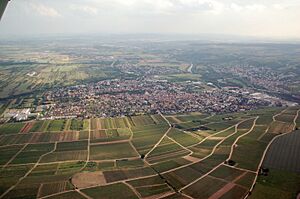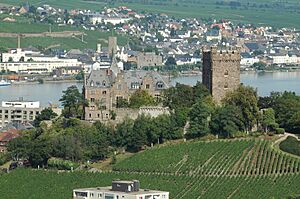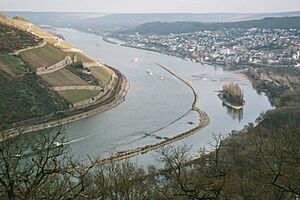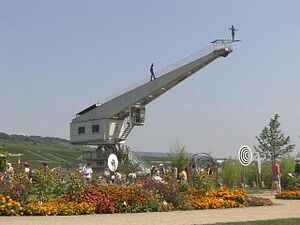Bingen am Rhein facts for kids
Quick facts for kids
Bingen am Rhein
|
||
|---|---|---|
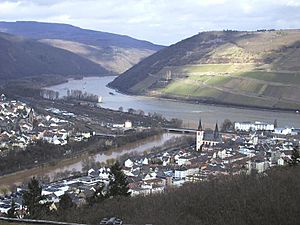 |
||
|
||
| Country | Germany | |
| State | Rhineland-Palatinate | |
| District | Mainz-Bingen | |
| Elevation | 89 m (292 ft) | |
| Population
(2022-12-31)
|
||
| • Total | 26,309 | |
| Time zone | CET/CEST (UTC+1/+2) | |
| Postal codes |
55411
|
|
| Dialling codes | 06721-06725 | |
| Vehicle registration | MZ, BIN | |
| Website | www.bingen.de | |
Bingen am Rhein is a town in the Mainz-Bingen district in Rhineland-Pfalz, Germany. It's a historic place located where the Nahe River meets the mighty Rhine River.
The town's first name was Bingium. This was a Celtic word. It might have meant "hole in the rock." This describes a shallow area in the river behind the famous Mäuseturm (Mouse Tower). Bingen was also the start of the Via Ausonia. This was a Roman military road that connected Bingen with another city called Trier.
Bingen is famous for the story of the Mouse Tower. In this tale, Bishop Hatto I of Mainz was supposedly eaten by mice! A very important person, Saint Hildegard von Bingen, was born not far from Bingen. She was a polymath (someone who knows a lot about many things). She was also an abbess, a mystic, and a musician. She was one of the most important medieval composers. Her music is still played today. The well-known poet Stefan George was also born in Bingen am Rhein.
Contents
Geography
Where Bingen is Located
Bingen is found just southeast of the "Rhine knee." This is a bend in the Rhine River. It sits by the Bingen Forest (Binger Wald). This forest is actually a low mountain range west of the town. Across the Rhine to the north, you can see the Rheingau range. This is part of the Taunus mountains.
In Bingen, the Nahe River flows into the Rhine. This area is known as the Rhine Gorge. Bingen marks the southern end of the UNESCO Rhine Gorge World Heritage Site. The Rochusberg (a mountain) is almost completely surrounded by the town.
Parts of Bingen
Bingen is made up of several smaller communities. Some of these include:
- Bingerbrück
- Büdesheim
- Dietersheim
- Gaulsheim
- Dromersheim (known as the birthplace of icewine)
- Inner town
- Kempten am Rhein
- Sponsheim
History
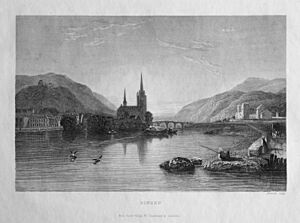
Ancient Times
People lived in Bingen even before the Romans arrived. This was because its location was great for travel. It was where the Nahe and Rhine Rivers met. The first settlement was likely Celtic (Gaulish). It was called Binge, meaning "rift."
In the early 1st century AD, Roman soldiers came to Bingen. They called the town Bingium in Latin. The Romans built a wooden bridge over the Nahe River. They also built a fort there. A Roman monument to the god Mithras was found in Bingen.
Medieval Period
Around 335 to 360 AD, a Christian community was started in Bingen. A gravestone from this time can still be seen in Saint Martin's Basilica. After the Roman Empire weakened, Bingen became a Frankish royal estate. In 983, Emperor Otto II gave the town to Archbishop Willigis of Mainz.
The people of Bingen often tried to become independent. This led to fighting and destruction in 1165. In the 13th century, Bingen joined the Rhenish League of Towns. Klopp Castle (Burg Klopp) was built around this time. Bingen also took part in the German Peasants' War in 1525, but it was not successful. The town remained under the control of the Mainz Cathedral Chapter until the late 1700s. Like many towns in the valley, Bingen suffered from fires and wars.
Modern Period
From 1792 to 1813, Bingen was part of France. This was after French Revolutionary troops took over the left bank of the Rhine. In 1816, after the Congress of Vienna, Bingen became part of the Grand Duchy of Hesse-Darmstadt. The area of Bingerbrück became part of Prussia. This made Bingen a border town until 1871. That's when the German Empire was formed.
On June 7, 1969, Bingerbrück joined Bingen. Later, in 1972, Dromersheim and Sponsheim also joined. The name am Rhein (meaning "on the Rhine") was added to the town's name in 1982.
In 2008, Bingen hosted the State Garden Show. The areas along the Rhine were greatly improved for this event.
Jewish History in Bingen
A Jewish community lived in Bingen as early as the mid-12th century. They faced many challenges over the centuries. In 1198 or 1199, Christian residents attacked the Jewish quarter. The Jews were forced to leave the city. They returned later in the 13th century. In 1343, French Jews also settled in Bingen.
The archbishops of Mainz often demanded money from the Jewish community. In 1405, they even cancelled some debts owed to Jews. Notable rabbis taught in Bingen. One was Seligmann Oppenheim, who held a meeting of rabbis in 1455–56. The Jewish people were expelled again in 1507. They did not return until the second half of the 16th century.
In 1933, there were 465 Jewish people in Bingen. By 1939, this number dropped to 222 due to people leaving the country. The 169 Jews who remained in Bingen in 1942 were sent to concentration camps. Only four returned after World War II. The synagogue was destroyed in 1945. The Jewish community was not reestablished after the war.
Main Sights
Bingen has many interesting places to visit:
- Mouse Tower
- The old monastery church, the Basilica of St. Martin. It dates from the 15th century and has a Romanesque crypt.
- Klopp Castle (Burg Klopp)
- Rochuskapelle (Rochus Chapel)
- Drususbrücke (bridge) with a Romanesque bridge chapel
- Old Rhine Crane
- Haferkasten ("Oat Shed"), which now houses the Stefan-George-Museum.
- Puricellipalais, a grand building from 1780.
- Old Graveyard from the 19th century with a monument to Napoleon.
- Historical Museum, focusing on "Hildegard of Bingen."
- A Roman villa rustica (country house) in the Bingen Forest.
- Rhine Floodplain Special Protection Area.
- Bingerbrück Reiter Signal Box, a historic technological site.
- The Route der Industriekultur Rhein-Main ("Rhine-Main Industrial Culture Route"). This route connects industrial buildings along the Rhine.
Culture
Bingen 2008 State Garden Show
Bingen hosted the Rhineland-Palatinate State Garden Show from April 18 to October 19, 2008. The event took place along 2.8 km of the Rhine waterfront. It covered 24 hectares of exhibition space. Over 1.3 million people visited, much more than expected!
Regular Events
Bingen hosts many fun events throughout the year:
- Bingen swingt: A jazz music festival.
- Binger Open Air Festival: An alternative music festival.
- Nacht der Verführung: A wine festival held among the grapevines.
- Rhein im Feuerzauber: A big fireworks display over the Rhine.
- Rochusfest (Saint Roch's Festival): A church festival with a folk fair. It's also a pilgrimage for the Bishopric of Mainz.
- Winzerfest (winemakers' festival): This is the longest wine festival on the Rhine, lasting 11 days!
Economy and Infrastructure
The economy in Bingen is mostly about winegrowing. This is because three wine regions meet here: Rheinhessen, Mittelrhein, and Nahe. The town also gives its name to a winegrowing area called Bereich Bingen.
Other industries that used to be in Bingen have moved away. Today, service businesses are mainly found in the industrial park and the Scharlachberg commercial park. Tourism is also very important for Bingen.
Transport
Rail
The main train station, Bingen (Rhein) Hauptbahnhof, is in Bingerbrück. It is served by InterCity trains and one ICE line.
Bingen (Rhein) Stadt station is about 2 km east. It's important for local trains. There's also a stop in Bingen-Gaulsheim. Bingen has two main stations because of history. The main station was once a Prussian border station. The station in town belonged to a different railway company.
Road
Bingen is close to the Autobahnen A 60 and A 61. These highways are connected to the town by Bundesstraße 9.
Water
Today, only private boats are very important on the water. The old cargo harbor is no longer used. The former winter harbor is now a marina.
Tourist boats like Köln-Düsseldorfer and Bingen-Rüdesheimer Fahrgastschifffahrt have stops here. A passenger ferry and a car ferry connect Bingen with Rüdesheim.
Education
Bingen has several schools and learning centers:
- University of Applied Sciences Bingen
- Stefan-George-Gymnasium (a type of high school)
- Hildegardisschule, a Catholic private school
- Rochus-Realschule (another type of secondary school)
- Rupertus Hauptschule (another type of secondary school)
- Berufsbildende Schule Bingen (vocational school)
- Bingen town library
- Folk high school
Notable People
Many famous people have connections to Bingen:
- Hildegard of Bingen (1098–1179): A very important abbess, writer, composer, and mystic. A girls' school in Bingen is named after her. In 2012, Pope Benedict XVI named her a Doctor of the Church.
- Philipp Foltz (1805–1877): A painter.
- Heinrich Brück (1831–1903): A Bishop of Mainz.
- Alice Bensheimer (1864–1935): A politician and feminist.
- Theodor Hilsdorf (1868–1944): A photographer.
- Stefan George (1868–1933): A famous poet.
- Carl Friedberg (1872–1955): A pianist and music teacher.
- Jacob Hilsdorf (1872–1916): A photographer.
- Mary Roos (born 1949): A singer and actress.
- Tina York (born 1954): A singer.
- Thomas Kling (1957–2005): A lyric poet.
- Peter Frey (born 1957): A journalist.
- Jan Schlaudraff (born 1983): A footballer and the first national player from Bingen.
Twin towns – sister cities
Bingen am Rhein has sister city relationships with:
 Hitchin, England, United Kingdom (since 1958)
Hitchin, England, United Kingdom (since 1958) Nuits-Saint-Georges, France (since 1960)
Nuits-Saint-Georges, France (since 1960) Venarey-les-Laumes, France (since 1967)
Venarey-les-Laumes, France (since 1967) Prizren, Kosovo (since 1968)
Prizren, Kosovo (since 1968) Anamur, Turkey (since 2011)
Anamur, Turkey (since 2011) Kutná Hora, Czech Republic (since 2011)
Kutná Hora, Czech Republic (since 2011)
See also
 In Spanish: Bingen am Rhein para niños
In Spanish: Bingen am Rhein para niños




